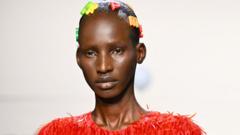Arop Akol, a budding model, is quickly becoming a name to reckon with in the fashion industry, boasting a chic style characterized by flowing braids and a natural elegance. After being inspired by modelling since childhood, Akol has spent the last three years jet-setting around the world, walking runways for high-profile brands in cities like London and Paris. The 5ft 10in beauty, originally from South Sudan, reflects on her journey and the increasing visibility of models from her home country in the global fashion scene.
South Sudanese models are gaining acclaim not only for their beauty but also for their unique heritage. Akol notes that the modelling landscape is brimming with talent from South Sudan, emphasizing the growing number of successful faces like Naomi Campbell’s fellow runway stars Anok Yai and Adut Akech. The IMG models notably represent a remarkable lineage of South Sudanese individuals who have navigated the gritty realities of their homeland to capture attention on international stages.
With a staggering 20% of the top 50 "future stars" hailing from South Sudan, the fashion industry has increasingly turned its spotlight on the incredible allure of these models, driven by their distinctive physical characteristics. Casting agent Lucia Janosova recognizes this phenomenon: "Of course they are beautiful... beautiful skin, the height." Yet, the exact motivations behind fashion brands' preferences remain elusive.
Delving deeper, model Akur Goi suggests that what sets South Sudanese models apart may extend beyond aesthetics; their resilience often serves as an inspiring narrative. Many fled a war-torn homeland in search of a better life, and after gaining international recognition, adapt to a world that may initially feel alien. Akol too faced challenges, recalling her initial encounter with an agency that placed financial burdens on her. Fortunately, she later found a reputable agency that represented her talents appropriately.
Despite the promising nature of their careers, South Sudanese models often grapple with familial expectations and cultural perceptions, which sometimes equate modelling with impropriety. Akol’s own family was initially unsupportive of her aspirations, a common theme echoed by many models from similar backgrounds. However, societal views are evolving as successful models contribute to their families’ welfare and reshape cultural narratives.
South Sudanese participants in initiatives like South Sudan Fashion Week are beginning to forge a better path for socio-economic mobility through the arts, with increasing acceptance among urban populations. In the face of adversity, the legacy of trailblazers like Alek Wek continues, as newer generations hold promise for the future of South Sudanese representation in modelling.
As demand for diversity swells within the fashion industry, the young models of South Sudan echo a sentiment of perseverance. "We [models] need to go out there and meet people. We are here to stay," asserts Akol. With their natural beauty and inspiring stories, South Sudanese models are poised for long-lasting impacts in the ever-evolving world of fashion.



















